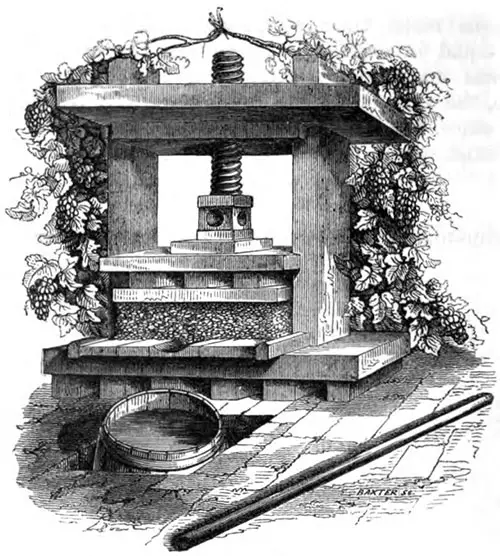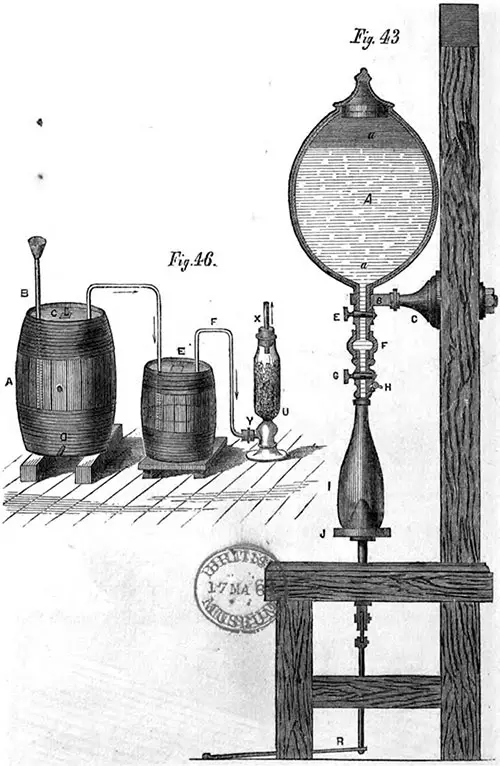Bordeaux Wine District - 1862

The Smaller Wine Press
THE WINES OF BORDEAUX
The wines bearing the general appellation of Bordeaux wines, because they grow in the country surrounding this celebrated emporium, and are shipped to all parts of the world from its harbor, are divided into four principal classes:
1. Vins de Medoc— Wines of the Medoc (further details below).
2. Vins de Grave—Wines growing on the gravelly soil in the immediate neighborhood of Bordeaux, and on both sides of the rivers Dordogne and Garonne, within a certain distance of their confluence.
***Of the red wines grown on this soil the most renowned are those of Chateau Haut-Brion. Of much less note, are the wines of Merignac, Carbonnieux, and Leognan. Among the white wines, the most popular are the Sauternes, the Barsac, the Preignac, and the Bommes. Again, among these, the most superior is the white wine of Chateau Iquem, in the parish of Sauterne.
3. Vins des Cotes—Wines growing on the range of hills at the right side of the Garonne, from Ambares to Saint Croix du Mont. Also, on the right side of the Dordogne, between Bourg and Fronsac. Of these wines, the most celebrated are those of St. Emilion. Less choice are those of St. Laurent, St. Hippolyte, St. Christophe de St. Georges, and of Pommerol. The soil in these vineyards is generally a combination of lime and clay, with a subsoil of hard rock. They generally decline toward south and west.
4. Vins de Palus. — Vines growing on the bottom-lands of the Garonne, near Bordeaux. These are less distinguished than the above, although they are wines of a fine color and a good deal of spirit. The best of them are grown in the communes of Queyries and Montferrand.
Wines of the Medoc District
The small peninsula formed by the River Gironde on its eastern side and the Atlantic on the western is generally allowed to contain some of the finest vineyards in the world. This is the renowned Medoc district. It offers itself to the eye as a softly-undulating plain, with gentle declivities all along the river, and sandy downs, frequently interrupted by marshes and lagoons, along the sea-side. It is principally on those slopes above the Gironde where the famous Bordeaux wines are raised in their greatest perfection.
The general formation of the soil consists here of a compound of quartzose fragments with clay, strongly impregnated with oxide of iron. This uppermost stratum rests either on a bed of pure sand, or on a conglomerate of gravel with clay, and a strong admixture of iron oxide, which composition—very hard in some cases, and soft and crumbling in others—goes by the local name of “ alios.”
This diversity of the soil, or, rather, the great variation in the mixture of its component elements, is the principal cause for the great diversity of its productions.
As a proof of this, we find, in many instances, wines of inferior quality in the close neighborhood of the very best vineyards, and, vice versa, streaks of good soil amid poor vineyards, giving a much better wine than the surrounding grounds.
The culture of the vine in the Medoc district varies more or less from the methods used in other parts of France; but the training of the vines on laths or on trellises near the ground is a characteristic not to be found anywhere else but here.
The most extensively cultivated grapes in the Medoc are the Cabernet-Sauvignon, the Franc-Cabernet, the Merlot, the Malbec, and the Verdot; but it is especially the Cabernet-Sauvignon which forms the basis of the Medoc vineyards, and, in fact, is to the great Medoc wines what the Pineau is to the wines of the Cote d’Or in Burgundy.
This unsurpassed grape is the chief ingredient of the celebrated wines of Pauillac, St. Julien, and Margaux; and about five-eighths of the plantations of Lafitte, Mouton, Latour, Leoville, Margaux, Rauzan, etc., belong to the same. The wine made of it is of a splendid color and an exquisite bouquet.
A little tart at the beginning, it requires to be kept in wood for four years, and then for two in the bottle, to arrive to its full maturity. It gains in excellence up to its fifteenth year and preserves all its qualities till the twentieth; beyond this, it loses gradually some of its smoothness and becomes more and more dry.
The method of cultivation is uniform all through the Medoc district and does not present any striking difference from the methods pursued in other parts of France.
The vines are generally planted from April to June. The distance observed is one meter and ten centimeters between the vines on one and the same line, and only one meter between the rows.
In the second year the vine is pruned to two or three eyes; in the third, it begins to be trained on a trellis by tying two sprigs, each with two or three eyes, to the lath. The pruning commences usually in November and lasts till January.
In the Medoc district, the vine is in blossom in the middle of June, and the grape ripens, in favorable years, about the middle of September. In such years the vintage begins on the 20th of September and lasts to the 1st of October.
If it takes place altogether in this month, the year is pronounced to be middling or bad. Everybody may gather his grapes when he pleases, as there is no time fixed by statute for this purpose in the Department of the Gironde, to which the Medoc district belongs.
The grapes are carefully picked and cleaned of green or rotten berriesile before they are taken to the press-room. Here, the wine presses stand, generally three of them, ranged on one side, and the vats along the opposite wall.
The berries are all plucked from their stalks, which is done either with rakes or an instrument called an egrappoir. After this, they are trodden down in tubs, which generally have a hole in the bottom through which the must escapes.
This is taken to the vat, which is scrupulously cleaned and sponged with brandy. The vat being once full, must be left perfectly quiet until the wine is formed, which may take some four or five days, or even longer, according to the temperature, weather, ripeness of the grapes, etc.
As soon as the must has lost its sugary taste, and has turned fairly into wine, it is drawn carefully into casks, during which operation great care is taken not to let any foreign matter be mixed with the pure juice of the grape. The filling of the casks must be done as quick as possible.
During the first month they must be filled up every four or five days; the second month, once in eight days; and subsequently once in fifteen, until the wine is drawn off.
This has to be done three times during the first year, viz., in January or February, in June, and in September. In the following years, it is sufficient to draw only twice.
Ordinarily, the Medoc wines are left four years in the cask before they are bottled; and in two years more the will be perfectly mellow and ready for the market.
The Medoc district contains about 20,000 hectares of wine-land. The average produce is at the rate of two tuns (say 18 hectolitres and 24 liters) per hectare, amounting in all to 40,000 tuns.
Of this quantity, about 4500 belong to the first-class wines, an equal quantity to the second but still superior class, and the balance to ordinary wines.
The superior wines of the Medoc are classified in the Bordeaux commerce into five different qualities. The first class contains only three wines, which are ranged as follows:
- Chateau Margaux, 100—110 tuns per year.
- Chateau Lafitte, 120—150 tuns per year.
- Chateau Latour, 70—90 tuns per year.
The vineyard of Chateau Margaux contains 80 hectares. The soil consists of a gray gravel, with a substratum of “alios.” The greater part of the vineyard looks toward east and west, but the best part of it inclines to south and north.
The Cabernet-Sauvignon vine occupies about one half of this celebrated vineyard. In a first-rate year, the wine of Chateau Margaux surpasses by far every other Bordeaux wine, even Lafitte and Latour not excepted; but in less favorable years these two wines are superior to their great rival.
The vineyard of Chateau Lafitte contains 47 hectares. Its situation is various but mostly northerly. The soil, and especially the subsoil, is very rich in quartz pebbles.
Chateau Latour contains only 42 hectares. Its soil is very gravelly and inclines mostly toward south and north.
APPARATUS FOR WINE MAKING
P 3
Apparatus for Wine Making © 1851 A History and Description of Modern Wine
A. Haraszthy, "The Wines of Bordeaux," and "Wines of the Meloc District," in Grape Culture Wines and Wine Making: With Notes Upon Agriculture and Horticulture, New York: Harper & Brothers, 1862, p. 107-114. Edited by E. B. Gjenvick 2019.
